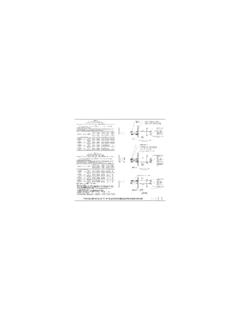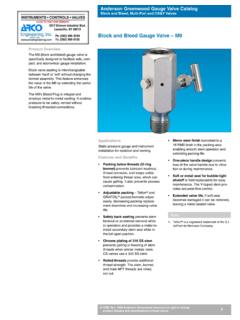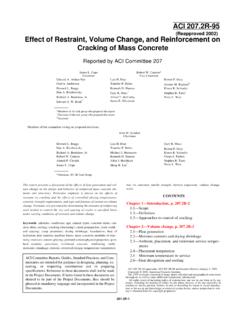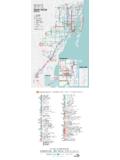Transcription of SUGI 31 Statistics and Data Anal ysis
1 Paper 207-31 introducing the glmselect PROCEDURE for Model SelectionRobert A. Cohen, SAS Institute Inc. Cary, NCABSTRACTThis paper describes the glmselect procedure, a new procedure in SAS/STAT software that performsmodel selection in the framework of general linear models. This procedure supports a variety of modelselection methods, including the LASSO method of Tibshirani (1996) and the related LAR method of Efronet al. (2004). The procedure enables selection from a very large number of effects (tens of thousands)and offers extensive capabilities for customizing the selection with a wide variety of selection and faced with a predictive modeling problem that has many possible predictor effects dozens, hun-dreds, or even thousands a natural question is What subset of the effects provides the best model forthe data?
2 Statistical model selection seeks to answer this question, employing a variety of definitions ofthe best model as well as a variety of heuristic procedures for approximating the true but computationallyinfeasible solution. The glmselect procedure implements statistical model selection in the framework ofgeneral linear models. Methods include not only extensions to GLM-type models of methods long familiarin the REG procedure (forward, backward, and stepwise) but also the newer LASSO and LAR methods ofTibshirani (1996) and Efron et al. (2004), that while the model selection question seems reasonable, trying to answer it for real data can lead toproblematic pitfalls, including Only one model is selected, and even that is not guaranteed to be the best ; there may be other,more parsimonious or more intuitively reasonable models that may provide nearly as good or evenbetter models, but which the particular heuristic method employed does not find.
3 Model selection may be unduly affected by outliers. There is a selection bias because a parameter is more likely to be selected if it is above its expectedvalue than if it is below its expected value. Standard methods of inference for the final model are invalid in the model selection some degree, these pitfalls are intrinsic, and they have even led some experts to stridently denouncemodel selection. However, certain features of glmselect , in particular the procedure s extensive capa-bilities for customizing the selection and its flexibility and power in specifying complex potential effects, canpartially mitigate these main features of the glmselect procedure are as follows.
4 Model Specification offers different parameterizations for classification effects supports any degree of interaction (crossed effects) and nested effects supports hierarchy among effects provides for internal partitioning of data into training, validation, and testing roles Selection Control provides multiple effect selection methods1 Statistics and Data AnalysisSUGI31 enables selection from a very large number of effects (tens of thousands) offers selection of individual levels of classification effects provides effect selection based on a variety of selection criteria provides stopping rules based on a variety of model evaluation criteria provides leave-one-out andk-fold cross validation Display and Output produces graphical representation of selection process produces output data sets containing predicted values and residuals produces macro variables containing selected models supports parallel processing of BY groups supports multiple SCORE statementsMODEL SELECTION METHODSThe glmselect procedure
5 Extends the familiar forward, backward, and stepwise methods as imple-mented in the REG procedure to GLM-type models. Quite simply, forward selection adds parameters oneat a time, backward elimination deletes them, and stepwise selection switches between adding and deletingthem. You can find details of these methods in the PROC glmselect and PROC REG addition to these methods, PROC glmselect also supports the newer LASSO and LAR methods. Inthe Customizing the Selection Process section on page 3 you can find details of how all these methodscan be customized using a variety of fit criteria that are described in the Criteria Used in Model SelectionMethods section on page ANGLE REGRESSION (LAR)Least angle regression was introduced by Efron et al.
6 (2004). Not only does this algorithm provide aselection method in its own right, but with one additional modification it can be used to efficiently produceLASSO solutions. Just like the forward selection method, the LAR algorithm produces a sequence ofregression models where one parameter is added at each step, terminating at the full least-squares solutionwhen all parameters have entered the algorithm starts by centering the covariates and response and scaling the covariates so that they allhave the same corrected sum of squares. Initially all coefficients are zero, as is the predicted predictor that is most correlated with the current residual is determined and a step is taken in thedirection of this predictor.
7 The length of this step determines the coefficient of this predictor and is chosenso that some other predictor and the current predicted response have the same correlation with the currentresidual. At this point, the predicted response moves in the direction that is equiangular between these twopredictors. Moving in this direction ensures that these two predictors continue to have a common correlationwith the current residual. The predicted response moves in this direction until a third predictor has thesame correlation with the current residual as the two predictors already in the model.
8 A new direction isdetermined that is equiangular between these three predictors, and the predicted response moves in thisdirection until a fourth predictor joins the set having the same correlation with the current residual. Thisprocess continues until all predictors are in the SELECTION (LASSO)LASSO (Least Absolute Shrinkage and Selection Operator) selection arises from a constrained form ofordinary least squares where the sum of the absolute values of the regression coefficients is constrainedto be smaller than a specified parameter. More precisely, letX=(x1,x2.)
9 ,xm)denote the matrix ofcovariates and letydenote the response, where thexis have been centered and scaled to have unit2 Statistics and Data AnalysisSUGI31 standard deviation and mean zero, andyhas mean zero. Then, for a given parametert, the LASSO regression coefficients =( 1, 2,.., m)are the solution to the constrained optimization problemminimize||y X ||2subject tom j=1| j| tProvided that the LASSO parametertis small enough, some of the regression coefficients will be exactlyzero. Hence, you can view the LASSO as selecting a subset of the regression coefficients for each LASSO parameter.
10 By increasing the LASSO parameter in discrete steps you obtain a sequence of regressioncoefficients where the nonzero coefficients at each step correspond to selected implementations (Tibshirani 1996) of LASSO selection used quadratic programming techniques tosolve the constrained least-squares problem for each LASSO parameter of interest. Later Osborne,Presnell, and Turlach (2000) developed a homotopy method that generates the LASSO solutions for allvalues oft. Efron et al. (2004) derived a variant of their algorithm for least angle regression that can be usedto obtain a sequence of LASSO solutions from which all other LASSO solutions can be obtained by linearinterpolation.
















